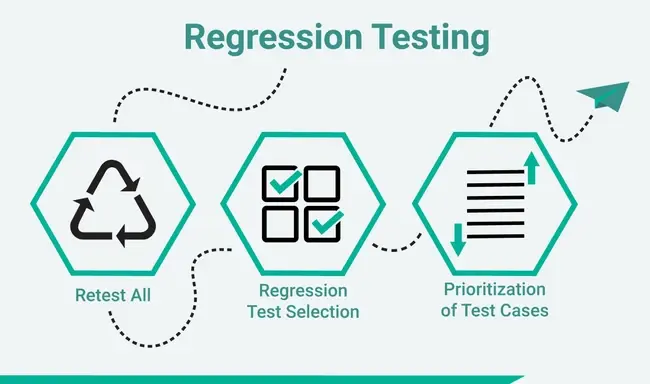Regression testing is one of the most important tools in a developer's arsenal. Designed to ensure a solution can continue to function as normal as it evolves, regression testing ensures the ongoing stability of software services and applications.
As a part of business continuity, with the correct process, product teams can instantly determine when there's a defect with their code, to preserve the end-user experience. Implemented regularly, this process also helps to reduce the risk of lengthy development plans being made redundant.
Here's everything you need to know about regression testing.

What is Regression Testing? An Introduction
Regression testing is a method of software testing used to confirm a recent code change or program update hasn't adversely affected the existing features in a piece of software. The process involves using a series of test cases or evaluations to track the performance of various functionalities within a test case.
While different companies and developers approach regression testing in their own unique way, most will perform this process regularly, whenever:
- Patch fixes are implemented into a system.
- The source code is optimised or enhanced for performance purposes.
- The codebase is "fixed" to address existing defects.
- New features or functionalities are added to a program.
- New requirements are implemented into an existing feature.
Generally, organisations will conduct a multitude of "regression tests", before integrating the intended changes into the primary development branch of the project.
Why is Regression Testing Important?
Developers and software testing vendors are constantly updating and enhancing their products to suit an evolving audience. However, even the slightest change to a piece of code can sometimes prompt unexpected consequences.
Regression testing allows companies to ensure changes and additions don't harm the existing functionality of the software.
Companies can use regression tests to catch bugs introduced into a new build before the code or programming is released into the entire system. With rapid regression testing, teams can quickly analyse the functionality of their software, and avoid implementing new bugs into the system.
Perhaps the most important goal of regression testing is allowing developers to make updates to their products, without risking the end-user experience. The process validates the functionality of new code while ensuring compatibility with existing functionality.
Also Read: Top 10 Tools For Regression Testing in 2022
How to Do Regression Testing: Step by Step
Regression tests can be performed in a multitude of different ways. For smaller projects, it's possible to conduct a regression test manually. Larger development teams often rely more extensively on "automated" regression testing, so they can save time when searching for bugs.
Regression testing can also be performed on an entire group of modified apps or software testing systems at the same time, or implemented on a one-by-one basis. In most cases, regression test cases need to be executed multiple times to ensure the validity of the code change.
As a part of a 'best practice guide', here are some of the steps commonly involved in regression testing:
Step 1: Determining test cases
The first stage of regression testing is deciding which “tests” the quality assurance team is going to repeat. The test cases chosen need to verify the main functions of the system still work, as well as more advanced event sequences.
If there are aspects of a codebase vulnerable to frequent updates or code changes, these need to be evaluated carefully too.
Step 2: Select testing tools
Depending on the element of a system or software solution being evaluated, the tools used for regression testing may vary. For instance, there are “API” testing tools which allow the QA professional to set input test criteria and observe outputs.
The most effective testing tools will help developers to test and report defects quickly while making it easy to pinpoint the source of any errors.
Step 3: Configure and execute tests
Before testing can begin, companies generally need to build a testing environment separate from other updates and alterations. This makes it easier to determine which code changes are influencing the software functionality.
Once an environment is available to safely run your tests, you can begin to implement your strategy and examine the output from your software.
Examples of Regression Testing
There are various examples of regression testing use cases in the software world. Here are some examples of what you might use regression testing to check:
Bug regression
If you’ve recently implemented a bug fix for a problem in your software, you can use a regression test to determine whether the problems have been addressed, without damaging the initial functionality of the solution.
This involves creating a copy of your code with the patches in place and tracking functionality, before rolling the fix out to the wider codebase and end-users.
Conversion/Port testing
Conversion/port testing is a form of regression testing which focuses on determining whether your software and code can run in a different environment. The code or a copy of the code is moved into a new platform, and a regression test is completed to see whether the software was successfully integrated.
This process can be followed up by “configuration testing”, which determines whether any changes occur when the code is configured for a new platform.
Feature testing
When companies implement new features into software products and services, they need to test to ensure the old functionality hasn’t been damaged.
For instance, if you wanted to give users a new way to log into their account on your software platform through Google, you’d add the Google integration to a version of the code, and ensure people can log in via the new tool, as well as existing methods.
In many examples of regression testing, the focus is on making sure not only that the new functionality or patch works, but that the existing functions of the system are still operating as normal.
While regression testing is important, companies must also focus on using open-source firewalls to ensure business continuity.
EM360, as you know it is about to change. CIA hackers, Google visionaries and some of the other biggest influencers from the tech industry are waiting to engage with you on the technologies that will define the future of enterprise tech. All you have to do is sign up as a premium EM360 Tech Community Member.
Features You Can Unlock As An EM360 Tech Community Member:
- Engage with the leading influencers of Cyber Security, Data Management, Enterprise AI and more.
- Gain access to our expanding library of exclusive content and resources.
- Get insights and opinions from industry leaders on the latest trending topics.
- Rise through the ranks to become an Industry Guru and GET PAID to express your opinion.
If you are a tech enthusiast, this is the place you need to be. Find out more about the EM360 Tech Community.







Comments ( 0 )